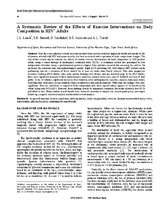| dc.contributor.author | Leach, Lloyd | |
| dc.contributor.author | Bassett, Susan | |
| dc.contributor.author | Smithdorf, G. | |
| dc.contributor.author | Andrews, Barry S. | |
| dc.contributor.author | Travill, Andre L. | |
| dc.date.accessioned | 2017-03-31T08:38:09Z | |
| dc.date.available | 2017-03-31T08:38:09Z | |
| dc.date.issued | 2015 | |
| dc.identifier.citation | Leach, L. (2015). A systematic review of the effects of exercise interventions on body composition in HIV+ adults. Open AIDS Journal, 9: 66-79 | en_US |
| dc.identifier.issn | 1874-6136 | |
| dc.identifier.uri | http://hdl.handle.net/10566/2705 | |
| dc.identifier.uri | http://dx.doi.org/10.2174/1874613601509010066 | |
| dc.description.abstract | Over the years, physical activity and exercise have been used to positively impact the health and quality of life of persons infected with HIV and, more recently, has been associated with a spectrum of body composition changes. The aim of this review was to examine the effects of various exercise interventions on body composition in HIV positive adults, using a search strategy of randomized, controlled trials (RCTs). A systematic review was performed by five independent reviewers using a predetermined protocol adapted from previous research for assessing the articles for inclusion, the extracted data, and methodological quality. Eight RCTs involving 430 (26% female) HIV positive adults performing exercise a minimum of thrice weekly for at least six weeks were finally selected: Four were progressive resistance training (PRT) studies, three were aerobic training (AT) studies, and one involved yoga. In the PRT studies, there were significant increases in three anthropometric measures, namely, body mass, sum of skinfolds and sum of limb girths. In the AT studies, significant decreases were found in seven anthropometric measures, namely, body mass index, waist-hip ratio, body mass, triceps skinfold, waist circumference and sum of skinfolds. With yoga, the changes were nonsignificant. Exercise contributes to improved body composition and, when applied safely, appears to be beneficial for adults living with HIV/AIDS. However, these findings should be interpreted cautiously due to the relatively few RCTs published to date. Future studies would benefit from increased attention to sample size, female participants, participant follow-up, complete statistical analysis and intention-to-treat analysis. | en_US |
| dc.language.iso | en | en_US |
| dc.publisher | Bentham Science Publishers B.V. | en_US |
| dc.rights | Open-Access License: This is an open access article licensed under the terms of the Creative Commons Attribution Non-Commercial License (http://creativecommons.org/licenses/by-nc/3.0/) which permits unrestricted, non-commercial use, distribution and reproduction in any medium, provided the work is properly cited. | |
| dc.subject | Acquired immune disease syndrome | en_US |
| dc.subject | Anthropometry | en_US |
| dc.subject | Body composition | en_US |
| dc.subject | Exercise | en_US |
| dc.subject | Human Immunodeficiency Virus (HIV) | en_US |
| dc.subject | Intervention | en_US |
| dc.subject | Physical activity | en_US |
| dc.subject | Randomised control trials | en_US |
| dc.subject | HIV | en_US |
| dc.subject | AIDS | en_US |
| dc.title | A systematic review of the effects of exercise interventions on body composition in HIV+ adults | en_US |
| dc.type | Article | en_US |
| dc.privacy.showsubmitter | FALSE | |
| dc.status.ispeerreviewed | TRUE | |
| dc.description.accreditation | Scopus | en_US |

